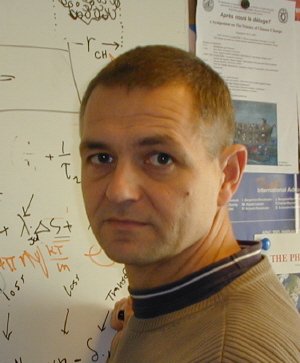Related Research Articles

Climate is the long-term weather pattern in a region, typically averaged over 30 years. More rigorously, it is the mean and variability of meteorological variables over a time spanning from months to millions of years. Some of the meteorological variables that are commonly measured are temperature, humidity, atmospheric pressure, wind, and precipitation. In a broader sense, climate is the state of the components of the climate system, including the atmosphere, hydrosphere, cryosphere, lithosphere and biosphere and the interactions between them. The climate of a location is affected by its latitude, longitude, terrain, altitude, land use and nearby water bodies and their currents.

El Niño is the warm phase of the El Niño–Southern Oscillation (ENSO) and is associated with a band of warm ocean water that develops in the central and east-central equatorial Pacific, including the area off the Pacific coast of South America. The ENSO is the cycle of warm and cold sea surface temperature (SST) of the tropical central and eastern Pacific Ocean.

Sunlight is a portion of the electromagnetic radiation given off by the Sun, in particular infrared, visible, and ultraviolet light. On Earth, sunlight is scattered and filtered through Earth's atmosphere, and is obvious as daylight when the Sun is above the horizon. When direct solar radiation is not blocked by clouds, it is experienced as sunshine, a combination of bright light and radiant heat. When blocked by clouds or reflected off other objects, sunlight is diffused. Sources estimate a global average of between 164 watts to 340 watts per square meter over a 24-hour day; this figure is estimated by NASA to be about a quarter of Earth's average total solar irradiance.

Climate variability includes all the variations in the climate that last longer than individual weather events, whereas the term climate change only refers to those variations that persist for a longer period of time, typically decades or more. Climate change may refer to any time in Earth's history, but the term is now commonly used to describe contemporary climate change. Since the Industrial Revolution, the climate has increasingly been affected by human activities.
Richard Siegmund Lindzen is an American atmospheric physicist known for his work in the dynamics of the middle atmosphere, atmospheric tides, and ozone photochemistry. He has published more than 200 scientific papers and books. From 1983 until his retirement in 2013, he was Alfred P. Sloan Professor of Meteorology at the Massachusetts Institute of Technology. He has disputed the scientific consensus on climate change and criticizes what he has called "climate alarmism."

The solar cycle, also known as the solar magnetic activity cycle, sunspot cycle, or Schwabe cycle, is a nearly periodic 11-year change in the Sun's activity measured in terms of variations in the number of observed sunspots on the Sun's surface. Over the period of a solar cycle, levels of solar radiation and ejection of solar material, the number and size of sunspots, solar flares, and coronal loops all exhibit a synchronized fluctuation from a period of minimum activity to a period of a maximum activity back to a period of minimum activity.

El Niño–Southern Oscillation (ENSO) is an irregular periodic variation in winds and sea surface temperatures over the tropical eastern Pacific Ocean, affecting the climate of much of the tropics and subtropics. The warming phase of the sea temperature is known as El Niño and the cooling phase as La Niña. The Southern Oscillation is the accompanying atmospheric component, coupled with the sea temperature change: El Niño is accompanied by high air surface pressure in the tropical western Pacific and La Niña with low air surface pressure there. The two periods last several months each and typically occur every few years with varying intensity per period.

Radiative forcing is the change in energy flux in the atmosphere caused by natural or anthropogenic factors of climate change as measured by watts / meter². It is a scientific concept used to quantify and compare the external drivers of change to Earth's energy balance. System feedbacks and internal variability are related concepts, encompassing other factors that also influence the direction and magnitude of imbalance.

The Upper Atmosphere Research Satellite (UARS) was a NASA-operated orbital observatory whose mission was to study the Earth's atmosphere, particularly the protective ozone layer. The 5,900-kilogram (13,000 lb) satellite was deployed from Space Shuttle Discovery during the STS-48 mission on 15 September 1991. It entered Earth orbit at an operational altitude of 600 kilometers (370 mi), with an orbital inclination of 57 degrees.

Solar irradiance is the power per unit area received from the Sun in the form of electromagnetic radiation in the wavelength range of the measuring instrument. Solar irradiance is measured in watts per square metre (W/m2) in SI units.

Earth's climate system is a complex system having five interacting components: the atmosphere (air), the hydrosphere (water), the cryosphere, the lithosphere and the biosphere. Climate is the statistical characterization of the climate system, representing the average weather, typically over a period of 30 years, and is determined by a combination of processes in the climate system, such as ocean currents and wind patterns. Circulation in the atmosphere and oceans is primarily driven by solar radiation and transports heat from the tropical regions to regions that receive less energy from the Sun. The water cycle also moves energy throughout the climate system. In addition, different chemical elements, necessary for life, are constantly recycled between the different components.

Mikhail Ivanovich Budyko was a Soviet and Russian climatologist and one of the founders of physical climatology. He pioneered studies on global climate and calculated temperature of Earth considering simple physical model of equilibrium in which the incoming solar radiation absorbed by the Earth's system is balanced by the energy re-radiated to space as thermal energy.

Henrik Svensmark is a physicist and professor in the Division of Solar System Physics at the Danish National Space Institute in Copenhagen. He is known for his work on the hypothesis that fewer cosmic rays are an indirect cause of global warming via cloud formation.

Nir Joseph Shaviv is an Israeli‐American physics professor. He is professor at the Racah Institute of Physics of the Hebrew University of Jerusalem.

The Active Cavity Radiometer Irradiance Monitor Satellite, or ACRIMSAT was a satellite carrying the ACRIM-3 instrument. It was one of the 21 observational components of NASA's Earth Observing System program. The instrument followed upon the ACRIM-1 and ACRIM-2 instruments that were launched on multi-instrument satellite platforms. ACRIMSAT was launched on 20 December 1999 from Vandenberg Air Force Base as the secondary payload on the Taurus launch vehicle that launched KOMPSAT. It was placed into a high inclination of 98.30°, at 720 km. Sun-synchronous orbit from which the ACRIM-3 instrument monitored total solar irradiance (TSI). Contact with the satellite was lost on 14 December 2013.

Polar amplification is the phenomenon that any change in the net radiation balance tends to produce a larger change in temperature near the poles than in the planetary average. This is commonly referred to as the ratio of polar warming to tropical warming. On a planet with an atmosphere that can restrict emission of longwave radiation to space, surface temperatures will be warmer than a simple planetary equilibrium temperature calculation would predict. Where the atmosphere or an extensive ocean is able to transport heat polewards, the poles will be warmer and equatorial regions cooler than their local net radiation balances would predict. The poles will experience the most cooling when the global-mean temperature is lower relative to a reference climate; alternatively, the poles will experience the greatest warming when the global-mean temperature is higher.

Berkeley Earth is a Berkeley, California-based independent 501(c)(3) non-profit focused on land temperature data analysis for climate science. Berkeley Earth was founded in early 2010 with the goal of addressing the major concerns from outside the scientific community regarding global warming and the instrumental temperature record. The project's stated aim was a "transparent approach, based on data analysis." In February 2013, Berkeley Earth became an independent non-profit. In August 2013, Berkeley Earth was granted 501(c)(3) tax-exempt status by the US government. The primary product is air temperatures over land, but they also produce a global dataset resulting from a merge of their land data with HadSST.

Patterns of solar irradiance and solar variation have been a main driver of climate change over the millions to billions of years of the geologic time scale.
Amy C. Clement is an atmospheric and marine scientist studying and modeling global climate change at the University of Miami's Rosenstiel School of Marine and Atmospheric Science.
References
- 1 2 3 4 5 6 7 "Nicola Scafetta, PhD" (PDF). Duke University. Archived from the original (PDF) on 2012-02-06. Retrieved 2012-08-21.
- ↑ "ACRIM Staff Information: Science and Instrument Team". ACRIM. Archived from the original on 2011-09-25. Retrieved 2012-08-21.
- ↑ Scafetta, Nicola (2001). "An entropic approach to the analysis of time series". University of North Texas . Retrieved 2012-08-21.
- ↑ "SCAFETTA NICOLA". unina.it. Retrieved 20 October 2017.
- ↑ Basgall, Monte (September 30, 2005). "Sun's Direct Role in Global Warming May Be Underestimated, Duke Physicists Report". Duke Today. Retrieved 2012-08-21.
- ↑ Dean, Ashley (October 19, 2005). "Hotter sun may affect global warming". The Chronicle . Retrieved 2012-08-21.
- ↑ Scafetta, Nicola; Paolo Grigolini (2002). "Scaling detection in time series: diffusion entropy analysis" (PDF). Physical Review E . 66 (3): 036130. arXiv: cond-mat/0202008 . Bibcode:2002PhRvE..66c6130S. doi:10.1103/PhysRevE.66.036130. PMID 12366207. S2CID 18679250. Archived from the original (PDF) on 2010-06-10.
- ↑ Goforth, Sarah (August 12, 2002). "A new perspective on teen pregnancy: Mathematical approach clarifies subtle patterns, points way to action". Dallas Morning News . Retrieved 2012-08-21.
- ↑ Ball, Philip (June 3, 2002). "Less lovin' in summer: Texan teen conception rates linked to school term times". Nature . doi:10.1038/news020527-15 . Retrieved 2012-08-21.
- ↑ Nicola Scafetta, "Empirical evidence for a celestial origin of the climate oscillations and its implications," Journal of Atmospheric and Solar-Terrestrial Physics, 2010 72, 951-970. Full text
- 1 2 Le Page, Michael (December 18, 2009). "Sceptical climate researcher won't divulge key program". New Scientist . Retrieved 2012-08-22.
- ↑ Craig Loehle and Nicola Scafetta, "Climate Change Attribution Using Empirical Decomposition of Climatic Data," The Open Atmospheric Science Journal, 2011 5, 74-86. Full text
- ↑ Scafetta, Nicola; Milani, Franco; Bianchini, Antonio (14 September 2020). "A 60-Year Cycle in the Meteorite Fall Frequency Suggests a Possible Interplanetary Dust Forcing of the Earth's Climate Driven by Planetary Oscillations". Geophysical Research Letters . 47 (18). Bibcode:2020GeoRL..4789954S. doi:10.1029/2020GL089954. S2CID 224921749 . Retrieved 23 November 2022.
- ↑ Scafetta, Nicola (18 September 2022). "CMIP6 GCM ensemble members versus global surface temperatures". Climate Dynamics . doi:10.1007/s00382-022-06493-w . Retrieved 20 March 2023.